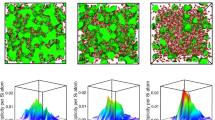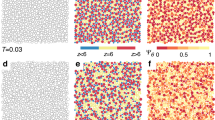Abstract
Atomic ordering in network glasses on length scales longer than nearest-neighbour length scales has long been a source of controversy1,2,3,4,5,6. Detailed experimental information is therefore necessary to understand both the network properties and the fundamentals of glass formation. Here we address the problem by investigating topological and chemical ordering in structurally disordered AX2 systems by applying the method of isotopic substitution in neutron diffraction to glassy ZnCl2. This system may be regarded as a prototypical ionic network forming glass, provided that ion polarization effects are taken into account7, and has thus been the focus of much attention8,9,10,11,12,13,14. By experiment, we show that both the topological and chemical ordering are described by two length scales at distances greater than nearest-neighbour length scales. One of these is associated with the intermediate range, as manifested by the appearance in the measured diffraction patterns of a first sharp diffraction peak at 1.09(3) Å-1; the other is associated with an extended range, which shows ordering in the glass out to 62(4) Å. We also find that these general features are characteristic of glassy GeSe2, a prototypical covalently bonded network material15,16. The results therefore offer structural insight into those length scales that determine many important aspects of supercooled liquid and glass phenomenology11.
This is a preview of subscription content, access via your institution
Access options
Subscribe to this journal
Receive 51 print issues and online access
$199.00 per year
only $3.90 per issue
Buy this article
- Purchase on Springer Link
- Instant access to full article PDF
Prices may be subject to local taxes which are calculated during checkout




Similar content being viewed by others
References
Moss, S. C. & Price, D. L. in Physics of Disordered Materials (eds Adler, D., Fritzsche, H. & Ovshinsky, S. R.) 77–95 (Plenum, New York, 1985)
Elliott, S. R. Medium-range structural order in covalent amorphous solids. Nature 354, 445–452 (1991)
Salmon, P. S. Real space manifestation of the first sharp diffraction peak in the structure factor of liquid and glassy materials. Proc. R. Soc. Lond. A 445, 351–365 (1994)
Elliott, S. R. Extended-range order, interstitial voids and the first sharp diffraction peak of network glasses. J. Non-Cryst. Solids 182, 40–48 (1995)
Gaskell, P. H. & Wallis, D. J. Medium-range order in silica, the canonical network glass. Phys. Rev. Lett. 76, 66–69 (1996)
Massobrio, C., Celino, M. & Pasquarello, A. Charge fluctuations and concentration fluctuations at intermediate-range distances in the disordered network-forming materials SiO2, SiSe2, and GeSe2 . Phys. Rev. B 70, 174202 (2004)
Wilson, M. & Madden, P. A. Short- and intermediate-range order in MCl2 melts: the importance of anionic polarization. J. Phys. Condens. Matter 5, 6833–6844 (1993)
Angell, C. A. & Wong, J. Structure and glass transition thermodynamics of liquid zinc chloride from far-infrared, Raman and probe ion electronic and vibrational spectra. J. Chem. Phys. 53, 2053–2066 (1970)
Biggin, S. & Enderby, J. E. The structure of molten zinc chloride. J. Phys. C 14, 3129–3136 (1981)
Desa, J. A. E., Wright, A. C., Wong, J. & Sinclair, R. N. A neutron diffraction investigation of the structure of vitreous zinc chloride. J. Non-Cryst. Solids 51, 57–86 (1982)
Angell, C. A. Spectroscopy simulation and scattering, and the medium range order problem in glass. J. Non-Cryst. Solids 73, 1–17 (1985)
Wilson, M. & Madden, P. A. Voids, layers and the first sharp diffraction peak in ZnCl2 . Phys. Rev. Lett. 80, 532–535 (1998)
Polsky, C. H. et al. Pressure-induced crystallization of vitreous ZnCl2 . Phys. Rev. B 61, 5934–5938 (2000)
Wilson, M. Nucleation and growth of polytypic-layered crystals from the network liquid zinc chloride. J. Chem. Phys. 118, 9838–9853 (2003)
Petri, I., Salmon, P. S. & Fischer, H. E. Defects in a disordered world: the structure of glassy GeSe2 . Phys. Rev. Lett. 84, 2413–2416 (2000)
Salmon, P. S. & Petri, I. Structure of glassy and liquid GeSe2 . J. Phys. Condens. Matter 15, S1509–S1528 (2003)
Boolchand, P. (ed.) Insulating and Semiconducting Glasses (World Scientific, Singapore, 2000)
Angell, C. A. Formation of glasses from liquids and biopolymers. Science 267, 1924–1935 (1995)
Crichton, W. A., Mezouar, M., Grande, T., Stølen, S. & Grzechnik, A. Breakdown of intermediate-range order in liquid GeSe2 at high pressure. Nature 414, 622–625 (2001)
Martin, J. D., Goettler, S. J., Fossé, N. & Iton, L. Designing intermediate-range order in amorphous materials. Nature 419, 381–384 (2002)
Salmon, P. S. Order within disorder. Nature Mater. 1, 87–88 (2002)
Ziman, J. M. Models of Disorder (CUP, Cambridge, 1979)
Zachariasen, W. H. The atomic arrangement in glass. J. Am. Chem. Soc. 54, 3841–3851 (1932)
Wright, A. C. et al. The structure of some simple amorphous network solids revisited. J. Non-Cryst. Solids 129, 213–232 (1991)
Bhatia, A. B. & Thornton, D. E. Structural aspects of the electrical resistivity of binary alloys. Phys. Rev. B 2, 3004–3012 (1970)
Salmon, P. S. The structure of molten and glassy 2:1 binary systems: an approach using the Bhatia-Thornton formalism. Proc. R. Soc. Lond. A 437, 591–606 (1992)
Grimley, D. I., Wright, A. C. & Sinclair, R. N. Neutron scattering from vitreous silica. J. Non-Cryst. Solids 119, 49–64 (1990)
Stølen, S., Grande, T. & Johnsen, H.-B. Fragility transition in GeSe2-Se liquids. Phys. Chem. Chem. Phys. 4, 3396–3399 (2002)
Ludwig, K. F. Jr, Warburton, W. K., Wilson, L. & Bienenstock, A. I. Liquid GeBr4. 1. A test of the anomalous x-ray scattering method as applied to disordered materials. J. Chem. Phys. 87, 604–612 (1987)
Sears, V. F. Neutron scattering lengths and cross sections. Neutron News 3, 26–37 (1992)
Acknowledgements
We thank M. Skeffington for permission to use his photo in Fig. 1a, R. L. McGreevy for assistance with the isotopes, P. Palleau for help with the diffraction experiment, A. C. Barnes for discussions on the SVD method, A. C. Hannon for a powder diffraction pattern on the polycrystalline phase of ZnCl2, A. C. Wright for providing his data for glassy ZnCl2, P. Buchanan and A. K. Soper for help with an earlier experiment at ISIS, R. Evans, P. A. Madden, C. Massobrio and M. Wilson for discussions, and the EPSRC and Alliance Programme for financial support. P.E.M. made the samples, G.J.C. prepared the diffractometer and R.A.M. made the data analysis. P.S.S. conceived the experiment and was involved in all aspects of the work.
Author information
Authors and Affiliations
Corresponding author
Ethics declarations
Competing interests
The authors declare that they have no competing financial interests.
Supplementary information
Supplementary Figure S1
The measured total structure factors for glassy ZnCl2 at 25(1) °C. (DOC 301 kb)
Supplementary Figure S2
The measured total pair distribution functions for glassy ZnCl2. (DOC 83 kb)
Supplementary Figure S3
The measured Faber–Ziman partial structure factors for glassy ZnCl2. (DOC 112 kb)
Rights and permissions
About this article
Cite this article
Salmon, P., Martin, R., Mason, P. et al. Topological versus chemical ordering in network glasses at intermediate and extended length scales. Nature 435, 75–78 (2005). https://doi.org/10.1038/nature03475
Received:
Accepted:
Issue Date:
DOI: https://doi.org/10.1038/nature03475
This article is cited by
-
Siliceous zeolite-derived topology of amorphous silica
Communications Chemistry (2023)
-
Ring-originated anisotropy of local structural ordering in amorphous and crystalline silicon dioxide
Communications Materials (2023)
-
Role of S/Se replacement on the structure of Ge20Se80-xSx glasses
Indian Journal of Physics (2023)
-
Exploration of glassy state in Prussian blue analogues
Nature Communications (2022)
-
Densification in transparent SiO2 glasses prepared by spark plasma sintering
Scientific Reports (2022)
Comments
By submitting a comment you agree to abide by our Terms and Community Guidelines. If you find something abusive or that does not comply with our terms or guidelines please flag it as inappropriate.



